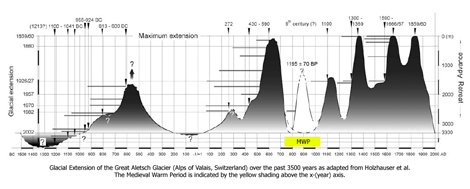Reference
Holzhauser, H., Magny, M. and Zumbuhl, H.J. 2005. Glacier and lake-level variations in west-central Europe over the last 3500 years. The Holocene 15: 789-801.
Description
Holzhauser et al. present a high-resolution record of glacial variation for the Great Aletsch glacier in the Alps of Valis, Switzerland (~46.38°N, 7.75°E), as part of an effort to develop a 3500-year climate history of west-central Europe. As they describe it, the Medieval Warm Period occurred between AD 800 and 1300; and based on data presented in their Figure 2 (reproduced below), glacial extension between AD 800 and 1000 was at a level equal to that of today. Furthermore, because glaciers in mountain areas are "highly sensitive to climate changes and thus provide one of nature's clearest signals of warming or cooling and/or dry and wet climate periods," in their estimation, they state that "one can say that the quasi periodical fluctuations of Alpine glaciers were driven by glacier-hostile (warm/dry) and glacier-friendly (cool/wet) periods." On this basis one can logically, albeit cautiously, conclude that temperatures during the Medieval Warm Period were likely as warm as they are today at the Great Aletsch Glacier.





